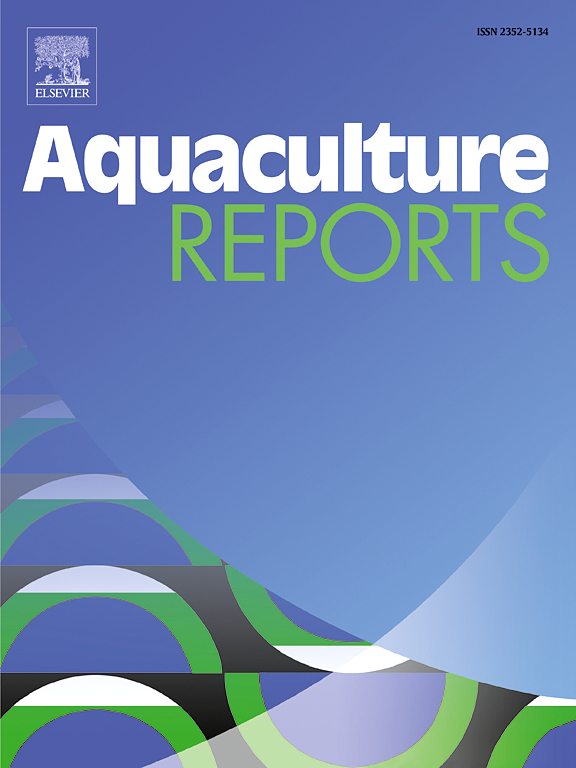Inclusion of different blends of poultry processed proteins in practical diets for African catfish (Clarias gariepinus) reared in RAS: Effects on nutrient digestibility, growth performance and fillet quality
IF 3.2
2区 农林科学
Q1 FISHERIES
引用次数: 0
Abstract
The present study aimed to test the effects of different dietary inclusion levels of fishmeal (F) and blends of poultry processed protein meals (P), i.e. poultry by-product meal, hydrolysed feather meal, dry-blood meal in African catfish (Clarias gariepinus). Fish were fed during 84 days with four practical diets, i.e. diet HF-LP (F: 90 g kg−1; P: 227 g kg−1), diet MF-MP (F: 45 g kg−1; P: 280 g kg−1), diet HF-HP (F: 90 g kg−1; P: 315 g kg−1), and diet LF-HP (F: 10 g kg−1; P: 392 g kg−1). Fish fed diet LF-HP showed the lowest protein and lipid digestibility coefficients (82 % and 92 % vs. 84 % and 94 %, respectively; p<0.05) compared to fish fed the other diets, and the worst performance in terms of final body weight (551 g vs. 673 g), feed intake (247 g d−1 vs. 301 g d−1), condition factor (0.83 vs. 0.86), specific growth rate (2.69 % d−1 vs. 3.14 % d−1), and feed conversion ratio (1.34 vs. 1.11) (p<0.001). Fish fed diet MF-MP reported the highest survival rate compared to other diets (96.8 % vs. 94.5 %; p<0.001). Fish fed diets with the highest inclusion rates of poultry by-product meal (140 g kg−1 or 165 g kg−1) and hydrolysed feather meal (125 g kg−1 or 135 g kg−1) were associated with the lowest fillet yield (46.2 % vs. 47.1 %) respect to fish fed the other diets (p<0.05). In conclusion, a diet with 10 g kg−1 of fishmeal and 392 g kg−1 of a blend of poultry processed animal proteins is not suitable to sustain the performance of African catfish, whereas a diet with a minimum content of fishmeal at 45 g kg−1 and a blend of poultry processed animal proteins at about 280 g kg−1 could be technically and economically attractive for the RAS farming of this species.
在 RAS 饲养的非洲鲶鱼(Clarias gariepinus)的实用日粮中添加不同的家禽加工蛋白混合物:对营养物质消化率、生长性能和鱼片质量的影响
本研究旨在测试非洲鲶鱼(Clarias gariepinus)不同日粮中鱼粉(F)和家禽加工蛋白粉(P)(即家禽副产品粉、水解羽毛粉、干血粉)混合物含量的影响。用四种实用日粮喂养非洲鲶鱼 84 天,即 HF-LP 日粮(F:90 克/千克-1;P:227 克/千克-1)、MF-MP 日粮(F:45 克/千克-1;P:280 克/千克-1)、HF-HP 日粮(F:90 克/千克-1;P:315 克/千克-1)和 LF-HP 日粮(F:10 克/千克-1;P:392 克/千克-1)。与饲喂其他日粮的鱼类相比,饲喂 LF-HP 日粮的鱼类蛋白质和脂质消化系数最低(分别为 82 % 和 92 % vs. 84 % 和 94 %;p<0.05),最终体重(551 克 vs. 673 克)、饲料摄入量(10 kg-1; P: 392 kg-1)和饲料消耗量(10 kg-1; P: 392 kg-1)表现最差。673 g)、摄食量(247 g d-1 vs. 301 g d-1)、体况系数(0.83 vs. 0.86)、特定生长率(2.69 % d-1 vs. 3.14 % d-1)和饲料转化率(1.34 vs. 1.11)方面的表现最差(p<0.001)。与其他日粮相比,饲喂 MF-MP 日粮的鱼类存活率最高(96.8 % 对 94.5 %;p<0.001)。与喂食其他日粮的鱼类相比,喂食添加率最高的家禽副产品粉(140 克/千克-1 或 165 克/千克-1)和水解羽毛粉(125 克/千克-1 或 135 克/千克-1)的鱼类的鱼片产量最低(46.2% 对 47.1%)(p<0.05)。总之,10 克/公斤-1 的鱼粉和 392 克/公斤-1 的家禽加工动物蛋白混合日粮不适合维持非洲鲶鱼的生长性能,而最低含量为 45 克/公斤-1 的鱼粉和大约 280 克/公斤-1 的家禽加工动物蛋白混合日粮在技术和经济上对非洲鲶鱼的 RAS 养殖都有吸引力。
本文章由计算机程序翻译,如有差异,请以英文原文为准。
求助全文
约1分钟内获得全文
求助全文
来源期刊

Aquaculture Reports
Agricultural and Biological Sciences-Animal Science and Zoology
CiteScore
5.90
自引率
8.10%
发文量
469
审稿时长
77 days
期刊介绍:
Aquaculture Reports will publish original research papers and reviews documenting outstanding science with a regional context and focus, answering the need for high quality information on novel species, systems and regions in emerging areas of aquaculture research and development, such as integrated multi-trophic aquaculture, urban aquaculture, ornamental, unfed aquaculture, offshore aquaculture and others. Papers having industry research as priority and encompassing product development research or current industry practice are encouraged.
 求助内容:
求助内容: 应助结果提醒方式:
应助结果提醒方式:


